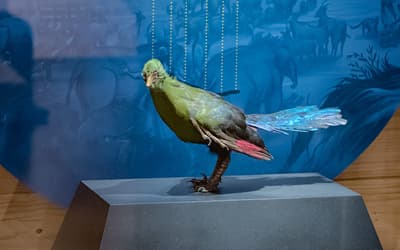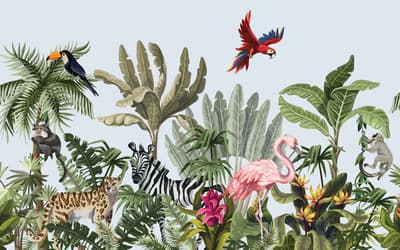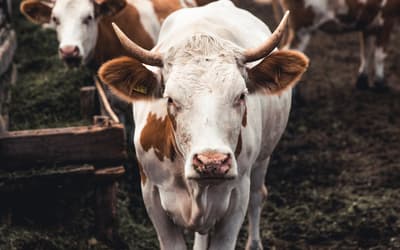Papers on this page cover a wide range of topics in zoology from the perspective of a recent creation within a biblical framework.

Microraptor: A Systematic View of Its Three Species: Cranial Elements
Dr. Gabriela Haynes • Sept. 10, 2025
The result of this analysis can contribute to the ongoing debate about whether those anatomical structures support a dinosaurian or a bird classification.

Defining Holobaramins of Order Galliformes Using Molecular Data
Marshall Jordan , et. al. • Aug. 6, 2025
The astonishing creative genius and power of God are displayed by the wonderful creatures he has made, especially the birds.

Molecular and Morphological Baraminology of Xenarthra
Matthew Cserhati • Feb. 19, 2025
Xenarthra represents an apobaramin within which several holobaramins may be discerned, using both mitochondrial DNA and morphological data.

Were Horses Designed to Be Ridden?
Caleb Harrier • Jan. 29, 2025
Were horses designed to be ridden? This is a question which, surprisingly, has been overlooked until more recent years.

Microraptor Reconstructed as a Bird
Joel Leineweber • May 15, 2024
The author performs a systematic, comparative anatomy of both form and function to show whether Microraptor would have appeared avian or reptilian.

Response to “The Debate over Classification of Archaeopteryx as a Bird”
Matthew McLain , et. al. • Dec. 6, 2023
Matthew McLain, Dr. Marcus Ross, Matt Petrone, Noël Lay, and Matthew Speights take issue with Dr. Gabriela Haynes’ 2022 discussion of the difference between birds and dinosaurs.

Reply to the “Response to ‘The Debate over Classification of Archaeopteryx as a Bird’”
Dr. Gabriela Haynes • Dec. 6, 2023
This paper aims to address some issues raised by McLain et al. (2023) in an article titled “Response to ‘The Debate over Classification of Archaeopteryx as a Bird.’”

Feathered Turtles?
Matthew Cserhati • Sept. 27, 2023
Evolutionists assert that several dinosaur species had feathers, but what do the genes say?

The Debate over Classification of Archaeopteryx as a Bird
Dr. Gabriela Haynes • Sept. 14, 2022
Based on several findings, no reason remains for Archaeopteryx to be classified as anything other than a bird.

The Evolution of Asexual to Sexual Reproduction: The Queen of Evolutionary Problems
Dr. Jerry Bergman • Dec. 15, 2021
The evidence is overwhelming and widely recognized by evolutionists that evolution by small steps cannot bridge the transition from asexual to sexual reproduction.

One of the Most Widely Used Quotes by D. M. S. Watson Vindicated
Dr. Jerry Bergman • Oct. 13, 2021
Critics have attempted to negate the effect of a common quote that evolution is accepted mainly because the only alternative, special creation, is unacceptable.

Implications of Creation Biology for a Neogene-Quaternary Flood/Post-Flood Boundary
Chad Arment • Nov. 4, 2020
While several current Flood models posit an Upper Cenozoic Flood Boundary, none of them address the problem of biblical kinds and their relationship Genesis.

Evidence for a Human Y Chromosome Molecular Clock: Pedigree-Based Mutation Rates Suggest a 4,500-Year History for Human Paternal Inheritance
Dr. Nathaniel T. Jeanson , et. al. • Dec. 4, 2019
Pedigree-based mutation rates act as an independent test of the young-earth creation and evolutionary timescales.

Big Gaps and Short Bridges: A Model for Solving the Discontinuity Problem
Change Laura Tan • July 6, 2016
This paper argues that the issue with the origin of life and the origin of biodiversity is not an issue of time, though deep time is problematical.

On the Origin of Eukaryotic Species’ Genotypic and Phenotypic Diversity
Dr. Nathaniel T. Jeanson , et. al. • April 20, 2016
This study shows that created heterozygosity, together with natural processes that are observable, is sufficient to account for species’ diversity.

Using Taxonomically Restricted Essential Genes to Determine Whether Two Organisms Can Belong to the Same Family Tree
Change Laura Tan • Nov. 4, 2015
How are all life forms connected? Are they linked by one giant family tree, a web, or a forest of family trees?

A Baraminic Study of the Blood Flukes of Family Schistosomatidae
Dr. Matthew E. Ingle , et. al. • June 24, 2015
This paper aims to determine the number of created kinds in this family of parasites, the original hosts, and what produced current species.

Mitochondrial DNA Clocks Imply Linear Speciation Rates Within “Kinds”
Dr. Nathaniel T. Jeanson • June 3, 2015
The mechanism of speciation remains one of the most contested scientific questions among both evolutionists and creationists.

An Initial Estimation of the Numbers and Identification of Extant Non-Snake/Non-Amphisbaenian Lizard Kinds: Order Squamata
Tom Hennigan • April 8, 2015
This paper is meant to lay creation groundwork for lizard systematics with the goal of estimating the number of baramins brought on the Ark.

Information Processing Differences Between Bacteria and Eukarya—Implications for the Myth of Eukaryogenesis
Change Laura Tan , et. al. • March 25, 2015
Based on differences in gene sets and molecular machines between bacteria and eukarya, we continue to demonstrate that unbridgeable evolutionary chasms exist.

Information Processing Differences Between Archaea and Eukarya—Implications for Homologs and the Myth of Eukaryogenesis
Change Laura Tan , et. al. • March 18, 2015
In the grand evolutionary paradigm, the origin of the eukaryotic cell represents one of the great mysteries and key hypothetical transitions of life.

Natural Selection: Assessing the Role It Plays in our World
Dr. Jean Lightner • March 4, 2015
Natural selection is controversial among many scientists, both in evolutionary and creationary circles.

Fossil Baramins on Noah’s Ark: The “Amphibians”
Dr. Marcus Ross • Sept. 17, 2014
When added to previously determined kinds of extant anurans, caudates, and gymnophionans, a total of 248 amphibian kinds may have been brought on board the Ark.

An Initial Estimate toward Identifying and Numbering Extant Tuatara, Amphisbaena, and Snake Kinds
Tom Hennigan • Feb. 19, 2014
The purpose of this paper is to use all available information in order to make an initial estimate of the identification and numbers of extant Lepidosaur kinds, except for the “lizards.”

An Initial Estimate toward Identifying and Numbering the Ark Turtle and Crocodile Kinds
Tom Hennigan • Jan. 8, 2014
Biosystematics is in great flux today because of the plethora of genetic research continually shedding light on organism relationships.

Recent, Functionally Diverse Origin for Mitochondrial Genes from ~2700 Metazoan Species
Dr. Nathaniel T. Jeanson • Dec. 11, 2013
The young-earth creation model currently lacks a robust explanation for molecular diversity.

An Initial Estimate of Avian Ark Kinds
Dr. Jean Lightner • Nov. 27, 2013
This paper will focus on identifying extant bird kinds.

An Initial Estimate Toward Identifying and Numbering Amphibian Kinds within the Orders Caudata and Gymnophiona
Tom Hennigan • Jan. 23, 2013
An initial attempt to count and identify biblical kinds in amphibian orders Caudata and Gymnophiona were estimated using current information and several key assumptions and guidelines.

Mammalian Ark Kinds
Dr. Jean Lightner • Oct. 31, 2012
Information on the class Mammalia was evaluated in an attempt to get a realistic estimate of what mammalian kinds would have been represented on the Ark.

An Evaluation of the Myth That “Nothing in Biology Makes Sense Except in the Light of Evolution”
Dr. Jerry Bergman • Feb. 8, 2012
I reviewed both the textbooks used for life science classes at the college where I teach and those that I used in my past university course work.
Zoology in Answers Research Journal
Zoology is defined as the study of the animal kingdom. Zoology studies animals’ behaviors, habitats, and natural history. Many researchers study zoology based on evolutionary presuppositions, and animals are often used as examples of evolutionary processes.
The aim of the research papers in Answers Research Journal (ARJ) is to consider zoological topics from the starting point of a recent creation within the biblical framework. These professional, peer-reviewed papers address issues related to zoology and how they relate to other areas of science. This journal considers animals in the light of creation, the evolutionary worldview, the fossil record, natural selection, dispersion after the flood, animal kinds and baraminology, the effects of the fall of man, dinosaurs, DNA, and the uniqueness of man.
As recorded in Genesis chapter 1, God created animals on day five and six during creation week. He created the animals after their kinds (Genesis 1:20–21, 24–25). In Genesis 6–9, God instructed Noah to bring representatives of all land animal kinds onto the Ark to protect them from being destroyed by the global flood. These biblical events provide the context for the topics listed above. Animals are found throughout the Bible and are a fascinating area of study.
Zoology provides a great opportunity to examine creation through the lens of the Bible. The papers included in this section look at topics in zoology from the perspective of the Bible along with research conducted with a biblical worldview. Each paper investigates some aspect of zoology.
